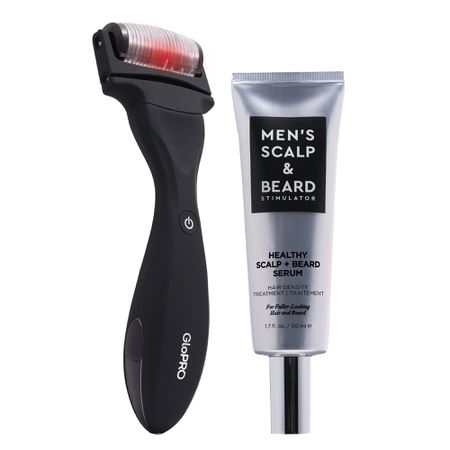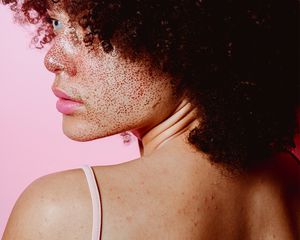
Glopro / Design by Cristina Cianci
Derma rollers have been used to address various skin concerns such as hyperpigmentation and scarring. A derma roller is a tool consisting of a cylinder-shaped head spiked with tiny needles attached to a handle that you roll across parts of your face. This results in very small punctures to the skin layer, which have been found to stimulate the skin’s natural formation of collagen. Use of this tool has evolved from being used exclusively as an in-office procedure with your dermatologist or aesthetician, to an at-home treatment available from retailers like Amazon.
A more recent development in the realm of derma rolling is the beard roller. Some claim has the effect of stimulating beard growth and with a seemingly ever-growing trend among men of having lush, full beards—role modeled by professional athletes like Brian Wilson of the LA Dodgers, or actors like Brad Pitt or Chris Hemsworth—it's no wonder why the tool has gotten a lot of attention lately. But does the science back up the claim? We tapped three experts for their thoughts.
Meet the Expert
- Dr. Dennis Gross is a board-certified cosmetic and medical dermatologist at Dr. Dennis Gross Dermatology.
- Dr. Ryan Turner is a board-certified dermatologist at Turner Dermatology.
- Dr. Rachel Maiman is a board-certified dermatologist at Marmur Medical.
What Are Beard Rollers?
Dr. Dennis Gross, a Board Certified Dermatologist in New York explains that beard rollers are just another name for an at-home microneedling devices. It is essentially a hand-held device that has a roller with a lot of small needles on its surface—similar to the average derma roller, but with a larger head. According to Dr. Rachel Maiman, a board-certified dermatologist practicing at Marmur Medical in New York, “Beard rollers are simply a derma-planing device. They implement the same mechanics but are intended to stimulate hair growth.”
How Do They Work?
“When [a beard roller] is rolled over the skin, it creates tiny puncture wounds," says Dr. Gross. "The objective of these puncture wounds is to signal an injury response in skin, which increases collagen production—key to healthy hair growth. It can be used to deliver active ingredients that plump, hydrate or stimulate collagen.”
Dr. Maiman adds that the idea of using beard rollers to stimulate hair growth is based on evidence that suggests microneedling promotes growth of hair on the scalp.
Can They Help With Beard Growth?
Dr. Ryan Turner, a board-certified dermatologist practicing in New York tells us that “There is some data suggesting the benefits of microneedling in scalp hair loss, but it has not been studied in beard growth." He goes on to say that anecdotal reports suggest that derma rolling may positively effect beard growth.
Dr. Maiman is skeptical about the efficacy of beard rollers to trigger hair growth on the face and cautions us that there is little scientific evidence that supports derma rollers being capable of promoting beard growth. "The jury is still out,” she says.
Maiman explains that support for the idea that microneedling may stimulate beard growth comes from a study done in patients with androgenetic alopecia (hormonal hair loss on the scalp) in 2015. “The participants in the study were divided into two groups," says Maiman. "After randomization, one group was offered weekly microneedling treatment with twice daily 5% minoxidil lotion, and the other was given only 5% minoxidil lotion. The mean change in hair count at week 12 was significantly greater for the microneedling group compared to the group that received minoxidil alone, prompting investigators to conclude that the microneedling-treated group was statistically superior to the minoxidil only-treated group in promoting hair growth in men with AGA.”
Sounds promising right? But as Dr. Maimon was quick to point out, “It is difficult to extrapolate the findings in the study and apply them to beard hair.” In addition, she notes, that “those allocated to the treated group in the study were treated with professional grade microneedling devices, akin to what is performed by a medical professional, not a derma roller intended for at-home use.”
Dr. Gross strongly questions the use of a beard roller to stimulate beard hair growth. “There is not enough evidence to support that beard rollers help with hair growth. If you’re looking to thicken hair, you should opt for Rogaine,” he says.
How to Use a Beard Roller For Best Results
If you do decide to try using a beard roller at home, Dr. Maiman has several tips to help avoid a bad experience:
- Look at the size of the needle. "The size of the needle should dictate safe frequency of use larger needles (0.5 mm) should only be used once or twice a week, whereas those that are smaller (i.e. 0.25 mm) can be used more often," she says.
- Wash your roller before treatment. Maimon also recommends washing the derma roller after each use and sanitizing it with rubbing alcohol.
- Avoid applying too much pressure while using the roller.
- Roll the tool back and forth in both directions in various planes (horizontal and vertical lines and also diagonal lines) for a consistent pattern throughout the beard. "A general rule of thumb is to roll 10 times in each plane," she says. "It’s important to note that, when changing directions or planes, the roller should be lifted—rather than twisted—to avoid skin injury."
Dr. Turner warns that pain or even bleeding during the beard microneedling process are a sign that you should immediately stop using the tool. He also recommends that you “avoid active acne or folliculitis spots to prevent infection.”
What to Look For In a Beard Roller
Dr. Maimon recommends looking for rollers containing needles of about 0.5-0.75mm. "They are more efficient at reaching the follicles and stimulating collagen production," she says. "Those smaller (0.25mm) will stimulate blood flow by way of the microcirculation but are limited in providing any additional benefits owing to their shallow depth of penetration.”
According to Dr. Maimon, “This at home derma roller, meant specifically for beards, contains a metal-crafted handle with rubber-resist technology, and features a head of 540 (0.5mm) titanium needles to create thousands of micro-injury channels that offer easier access for serums and moisturizers to penetrate and absorb deeply, while simultaneously helping to optimize follicle growth and repair."
He recommends using it twice weekly with the Activator Serum it comes with. "It contains critical amino acids for both collagen and keratin synthesis, as well as gluconolactone, a polyhydroxy acid (PHA) which protects against oxidative damage, activates stem cells, increases cell proliferation, and enhances the metabolic activity of the cells.”
BeautyBio promises this beard roller and serum set can help grow fuller-looking hair within a month of use. The roller is designed to “hug the jawline” to enable comfortable treatment without tugging. The product comes with a serum containing ingredients such as zinc, which the brand says strengthens hair shafts, and camellia leaf to moisturize and protect hair from free radicals.
Though not expressly targeted to beard growth—most derma rollers are not—we like the Beauty ORA Facial Microneedle Roller System Advanced Therapy for its .5 mm depth needles (within the range for home use mentioned by Dr. Maiman,), which penetrates deeper than many of the .25mm needle derma rollers we see on the market. The brand says its needles “gently penetrate the skin just enough to stimulate collagen and elastin production and help increase the absorption and penetration of serums and other skin care products by as much as 20 times compared to applying skincare products hand.” The brand also says that the roller helps stimulate and maintain hair within thinning hair areas on the scalp, which may indicate that it could be used to similar effect on the face.
Aftercare
Dr. Turner suggests hydrating the skin following use. “The application of a plain hyaluronic acid serum to hydrate and plump the beard area skin is the least irritating option," he says. "This supports healthy skin and as such healthy beard hair. Avoid immediate application of products that contain hydroxy acids, vitamin C, or retinol as the typical formulations can irritate or inflame the skin,” he advises."
Our experts are unanimous that the science behind beard rollers as a means of generating beard growth is still evolving and is based primarily on limited experiments using microneedling on the scalp and extrapolating those results to suggest the process may also work on the face. They also cite anecdotal evidence showing promise. The trend to grow beards shows no sign of abating, and many may wish to give the cell-generating microneedling process a try on their beards.
Bottom Line
Our experts are unanimous that the science behind beard rollers as a means of generating beard growth is still evolving and is based primarily on limited experiments using microneedling on the scalp and extrapolating those results to suggest the process may also work on the face. They also cite anecdotal evidence showing promise. The trend to grow beards shows no sign of abating, and many may wish to give the cell-generating microneedling process a try on their beards.



















